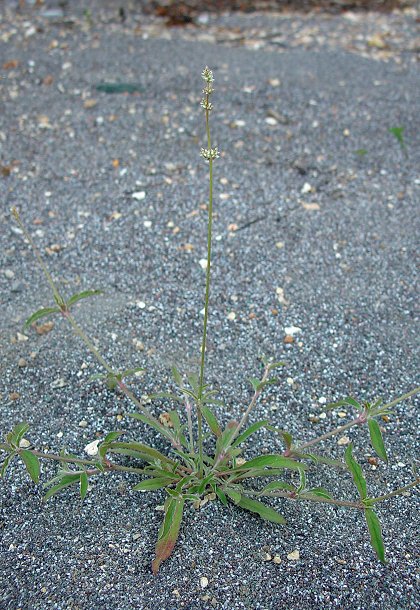Froelichia gracilis (Hook.) Moq.
Slender Snake-Cotton

Native
CC = 3
CW = 5
MOC = 60
© DETenaglia
Froelichia gracilis (Hook.) Moq.Slender Snake-Cotton | |
 |
Native CC = 3 CW = 5 MOC = 60 |
© DETenaglia |
|
Family - Amaranthaceae Habit - Taprooted annual forb. Stems - Ascending to erect, sometimes spreading at the base, to 50 cm, relatively slender, usually branched at the base, densely pubescent with woolly hairs.
Leaves - Opposite, positioned mostly below the stem midpoint, sessile or nearly so. Blades 2-8 cm long, the largest 0.5-1.0 cm broad, somewhat thickened or leathery, linear to narrowly lanceolate or oblanceolate, narrowed or tapered at the base, narrowed or tapered to a sharply or bluntly pointed tip, the margins entire, the upper surface densely pubescent with silky or woolly hairs but frequently becoming nearly glabrous at maturity, the undersurface densely persistently pubescent with woolly hairs.
Inflorescence - Terminal and lateral spikes. Lateral spikes sessile. Bracts subtending flowers densely lanate, pinkish-tinged at apex.
Flowers - Perfect. Sepals 5, fused most of their length into a persistent, conical or flask-shaped, papery tube, this 3.5-4.5 mm long, asymmetrical at the tip, becoming somewhat hardened and developing longitudinal rows of short spines and spiny basal tubercles after flowering, white to yellowish white, densely pubescent with woolly hairs, the lobes 1-2 mm long, oblong to lanceolate, bluntly to sharply pointed, greenish white, sometimes pinkish-tinged, more or less glabrous. Stamens 5, the filaments fused nearly their entire length, persistent, the anthers appearing sessile in the sinuses between 5 short, strap-shaped lobes. Ovary ovoid. Ovule 1. Style well developed, persistent, the stigma 1, capitate.
Flowering - May - September. Habitat - Sand prairies, upland prairies, bluff tops, forest openings, streambanks, fields, pastures, roadsides, open sandy or rocky disturbed areas. Origin - Native to U.S. Lookalikes - F. floridana. Other info. - This plant with cottony flowers occurs across most of Missouri. Its U.S. distribution includes most of the Midwest and Plains states, and also extends to the Atlantic coast, where it is considered introduced. Photographs taken at Logan Creek, Reynolds County, MO., 6-29-03 (DETenaglia); also about 4.5 miles southeast of Benton, Scott County, MO, 08-29-2011, and along the Katy Trail west of Dutzow, Warren County, MO, 8-30-2012 (SRTurner). |